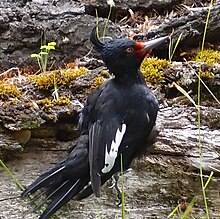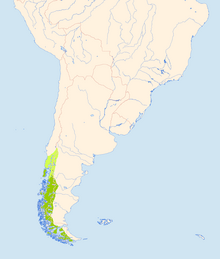Magellanic woodpecker
| Magellanic woodpecker | |
|---|---|

| |
| Male | |

| |
| Female | |
| Scientific classification | |
| Domain: | Eukaryota |
| Kingdom: | Animalia |
| Phylum: | Chordata |
| Class: | Aves |
| Order: | Piciformes |
| Family: | Picidae |
| Genus: | Campephilus |
| Species: | C. magellanicus
|
| Binomial name | |
| Campephilus magellanicus (King, 1827)
| |

| |
| Range of Magellanic woodpecker in South America in green, yellow-green and dark blue | |
The Magellanic woodpecker (Campephilus magellanicus) is a species of large woodpecker found in southern Chile and southwestern Argentina; it is resident within its range. This species is the southernmost example of the genus Campephilus, which includes the famous ivory-billed woodpecker (C. principalis).
Description



The Magellanic woodpecker is 36 to 45 cm (14 to 18 in) in length.
This species is mainly pure black, with a white wing patch and a grey, chisel-like beak. Males have a crimson head and crest. Females have a mainly black head, but an area of red coloration occurs near the base of the bill. Juvenile Magellanic woodpeckers resemble females of the species, but have a smaller crest and have a browner tinge to their plumage. In its range, this bird is unmistakable in appearance.
Several vocalizations are emitted by both sexes. Further information is needed to ascertain the function and role of these sounds. One frequent vocalization is an explosive, nasal call (tsie-yaa or pi-caa) given single or in a series (up to seven, sometimes more). Another loud call, usually from pairs, is a gargling call, which normally is emitted in series: prrr-prr-prrr or weeerr-weeeeerr. Like many species in Campephilus, their drum is a loud double knock.[6]
Habitat
Magellanic woodpeckers inhabit mature
Behaviour
Family groups also roost together. In one case, five individuals were observed roosting in a roughly 40 cm (16 in) vertical-depth hole. Breeding pairs are highly territorial and commonly try to aggressively displace and even attack conspecifics, sometimes doing so cooperatively with the juveniles that they had raised in prior years. A lethal attack was recorded in 2014.[8] When they are actively rearing nestlings, the juveniles are aggressively kept at a distance by their parents.
Diet and feeding
The species commonly co-occurs with the
Breeding

The Magellanic woodpecker breeds in the Southern Hemisphere's springtime, from October to January. Both sexes cooperate in excavating the nest in a tree trunk. The nesting holes are located at differing heights depending on the tree species and local habitat characteristics. The nest cavity typically is from 5–15 m (16–49 ft) above the ground. Females lay from one to four eggs, with a great majority of nests containing two eggs. The monogamous-breeding parents share all duties in nest excavation, incubation, territorial- and predator-defense, and young rearing. Adults normally breed every second year, a feature not documented in any other woodpecker species. Incubation lasts for 15 to 17 days, with the male reportedly doing almost all nocturnal incubation. The younger of the two nestlings, not uncommonly, dies from starvation. The young fledge at 45 to 50 days. After 2-3 years of being raised by and then assisting their parents, the young Magellanic woodpeckers become sexually mature. Successful breeding and pair bonds, however, do not usually occur until 4 to 5 years of age.
Ecology
Several potential predators are known, being almost exclusively avian raptors. These include white-throated hawks (Buteo albigula), variable hawks (B. polyosoma), bicolored hawks (Accipiter bicolor), and crested caracaras (Caracara plancus) (the latter most likely a predator only of young). When they encounter these potential predators while not nesting, Magellanic woodpeckers usually respond by being quiet and staying still. However, raptorial birds are often aggressively attacked during the nesting season.[9][11]
Status
Currently, the species is listed as of least concern, but population reductions have been reported. Forest loss and fragmentation are affecting the temperate forests of southern South America at an increasing rate, so these practices also represent a threat for the Magellanic woodpecker. The distribution of the species has contracted and was fragmented as a consequence of native forest clearance, especially in south-central Chile, where the species now is restricted to protected and relict areas. Changes in structural forest components after timber extraction, forest conversion to exotic plantations, and fragmentation due to forest clearance are the main threats to their populations. The species is protected from hunting in both Chile and Argentina, where it is not or very rarely illegally hunted.[12]
References
- . Retrieved 20 November 2021.
- ISBN 9781400831500.
- ^ ISBN 978-0395720431
- ISBN 978-1-4200-6444-5.
- ^ Chazarreta, M.L., Ojeda, V.S. and Trejo, A. (2011). Division of labour in parental care in the Magellanic Woodpecker Campephilus magellanicus. Journal of Ornithology. 152(2): 231–242.
- .
- ^ Ojeda, V. (2003) Magellanic Woodpecker Frugivory and Predation on a Lizard. The Wilson Bulletin 115(2):208-210.
- ^ Soto, E. et al. The Wilson Journal of Ornithology 128(1):180-184, 2016.
- ^ a b Chazarreta, L., V. Ojeda, and A. Trejo. 2010. Division of labour in parental care in the Magellanic Woodpecker Campephilus magellanicus. J. Ornithol. DOI: 10.1007/s10336-010-0570-4.
- ^ Vergara, P., and R. P., Schlatter. 2004. Magellanic Woodpecker (Campephilus magellanicus) abundance and foraging in Tierra del Fuego, Chile. J. Ornithol. 145: 343- 351.
- ^ Ojeda, V. 2004. Breeding biology and social behaviour of Magellanic woodpeckers (Campephilus magellanicus) in Argentine Patagonia. Eur. J. Wildl. Res. 50: 18–24.
- ^ Ojeda, V. 2009. Management strategies for keystone bird species: The Magellanic woodpecker in Nahuel Huapi National Park, Argentina. Park Science.
- Woodpeckers: A guide to the woodpeckers of the world” by Winkler, Christie and Nurney, ISBN 0-395-72043-5
External links
- Magellanic woodpecker videos on the Internet Bird Collection
- Magellanic woodpecker conservation program (Spanish)
- Stamps[usurped] (for Argentina, Chile) with RangeMap
- Aves de Chile: Magellanic woodpecker - Description and photos

